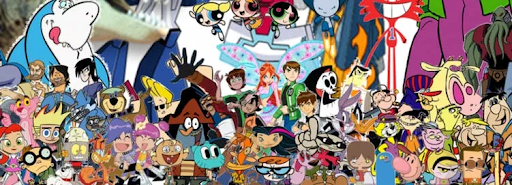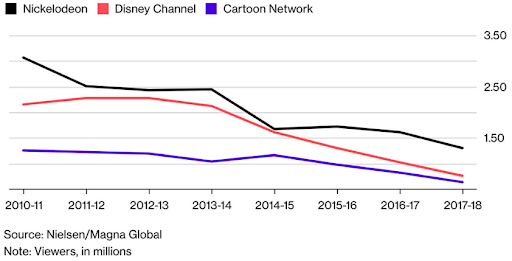Catlin Gabel School’s favorite cartoons at a glance
By Kenya Sei ‘20
On Friday, Feb 22, 2020 a group of six high school boys had possibly one of the most genuine conversations of their lives. In an overcrowded, small, wood cabin located in the center of Camp Westwind, they reminisced and bonded over their favorite childhood cartoons. Using their iPhones for light, they covered everything from “the best cartoons of all time,” to “the most slept-on cartoons of all time,” and even the “cartoons with the best plot lines/story arcs.” For each of them, this conversation brought back feelings of pure, carefree, childhood happiness.
Most kids remember the joy of waking up on a Saturday morning with no worries or obligations, and knowing that they had the whole day to veg out in front of the TV.
Believe it or not, this phenomenon is getting less and less common.
The inventions of smart gadgets like the iPhone and iPad, accompanied by streaming sites like Netflix, have decreased the number of children watching cable television over the past decades.
A prime example of this is the viewership rating of the top three TV networks dedicated to child television (cartoons and various other shows): Nickelodeon, Cartoon Network, and Disney Channel.
According to CartoonBrew.com, the viewership of these three networks has gone down 30% from 2010-2017.
The above graph shows the viewership of the three most popular children's TV Networks over
the past 10 years. Nickelodeon is shown in black, Disney Channel is shown in red, and
Cartoon Network is shown in Blue/ Purple. The graph is measured in millions of viewers.
There have been some measures to counteract this phenomena. TV networks have made mobile streaming available and TV channels are no longer limited to the box sitting in your living room.
This still isn’t enough to catch up to popular streaming networks.
In the past, TV providers, like Comcast or DirecTV would pay television channels, like Disney or HBO, to show their channels. TV channels would also pay TV shows in order to have the right to distribute their content.
The current system has cut out the middle man. Instead of paying channels who pay shows, streaming networks such as Netflix or Hulu, go straight to TV shows.
This gives them the power to streamline TV. Instead of paying for a channel that comes with a whole bundle of shows, streaming services can choose specifically what shows and movies they air and which ones they don’t.
This has resulted in fewer cartoons and child entertainment television shows getting pushed out to kids.
As part of the last generation to experience TV before online streaming, I was curious to see what children’s shows and cartoons Catlin Gabel School (CGS) Upper School (US) students watched when they were younger. Below is a pie chart of some of the favorite cartoons in the US:
Graph by Kenya Sei, showing data collected by surveys sent out to CGS US students.
I was surprised to see the sheer diversity of cartoon favorites, especially because some of these shows came out in completely different time periods.
The top five favorites overall were: “SpongeBob,” “Phineas and Ferb,” “Avatar The Last Airbender,” “Scooby Doo,” and “Tom and Jerry.”
All of these shows came from very different times. “Tom and Jerry” first aired in 1940, “Scooby Doo” in 1969, “SpongeBob'' in 1999, “Avatar” in 2005, and “Phineas and Ferb” in 2007.
Keep reading to see why people favored the cartoons they did.
Zoie Calora
Zoie Calora is a 15-year-old CGS ninth grader. Despite being born in 2004, Calora listed “Avatar the Last Airbender” and “Phineas and Ferb” as her two favorite cartoons of all time.
Calora was only one and three years old respectively when these shows first aired. She said the reason why she watched so many cartoons that came “before her time” was because of her older sister.
“What's interesting for me is that all my friends and I had older siblings. So we all watched the same thing, like ‘Kim Possible,’ ‘Ben 10,’ ‘Tom and Jerry,’ ‘Spongebob,’ and stuff like that,” Calora said.
Calora also said that being able to see herself in the characters in the shows she watched made her like them even more.
In reference to “Avatar the Last Airbender,” Calora said, “Now thinking about it, in a lot of the plots I could loosely see myself in the character, more than other TV shows. I didn’t necessarily look like the character, but I could see myself in them more than other shows.”
Joshua Hamlett
Another student at CGS that had a similar childhood experience was Joshua Hamlett. Hamlett is a 16-year-old sophomore at CGS.
Like Calora, Hamlett’s taste in childhood Cartoons were highly influenced by his older brother. His brother Nathanial was born in 1996 and is currently 23 years old.
Hamlett and his brother watched cartoons together when they were kids.
“I was in kindergarden when Nathaniel was in middle school, [so] whenever we would watch TV together, he never let me watch anything childish,” said Hamlett. “He especially hated Disney.”
This exposure to mature TV at a young age has surely had an effect on Hamlett’s cartoon preference.
His favorite cartoons include “Adventure Time,” “Steven Universe,” and “Naruto.” While “Naruto,” an anime series originating from Japan, is not a traditional cartoon, it still falls under the realm of animated television.
He enjoys these shows not only for their visual aspects, but also for their developed storylines. All three of these animated shows begin as fun, entertaining, and light-hearted shows, but later develop into more complex storylines. In “Naruto,” for example, the main character deals with being a social outcast and finding a way to stay determined despite the odds stacked against him.
In “Steven Universe,” the main character has to deal with the emotional burden of not having met his mom, but somehow having to live up to her standards. The show also explores themes of sexuaity and gender.
In “Adventure Time,” the main character has to deal with living in a world where he is the only human. He deals with father issues, identity crises, and relationship struggles with three main love interests.
Hamlett also said that he likes to “feel like he is growing up with the characters.” He gave the example of “Adventure Time.”
“You watch it when you are younger for [fun], but by the end you are really invested in it. [It’s] a show that you can grow up with,” said Hamlett.
Jasper Gleeson
Contrary to the last two students, senior Jasper Gleeson is the oldest in his family. Growing up, Gleeson did not watch many cartoons. He suspects “In retrospect my parents probably had a hand in that.”
However, whenever he did watch cartoons, he usually had the ability to choose what he wanted to watch. Originally as a child he watched whatever his mother would put on like, “PBS Kids and ‘Yo Gabba Gabba’ and stuff,” but later on in his childhood, Gleeson acquired a cartoon preference of his own.
Like many other kids, he too remembered watching shows like “Avatar the Last Airbender,”, “Looney Toons,” and “Tom and Jerry.” However his all-time favorite was “The Clone Wars,” based off the critically acclaimed sci fi series “Star War”.’.
“I love Star Wars like a ton,” Gleeson says. Gleeson described “The Clone Wars” as his ideal cartoon because he especially liked “how it is a combination of politics and actions. It gets everything in there and it makes for a killer combo.”
Even as a kid, Gleeson knew that he didn’t only like entertaining shows, but shows that also “had a little bit of thinking” in them.
In retrospect, Gleeson realizes that the shows that he watched were not the best forms of TV but they still hold a special place in his heart.
“I don’t know, I feel like a lot of it is the memories that you associate with shows from when you were a child and being able to remember how that show made you felt when you were like eight,” said Gleeson.
As someone who is roughly the same age as Gleeson, I can relate to what he is saying. Most kids born before the outburst of streaming sites and smart gadgets, around 2007-2010, can relate to this feeling as well, especially those born before 2003, who still hold vivid memories of waiting anxiously for a new episode of their favorite TV show to come on week after week. Nowadays, kids can rewatch and binge episodes of their favorite shows as much as they would like.



